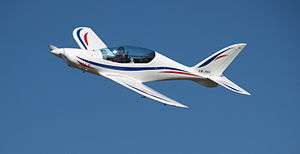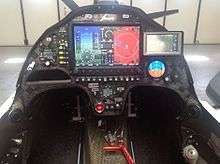Shark.Aero Shark
The Shark.Aero Shark is a conventionally laid out, single engine, low wing light aircraft which seats two in tandem. It was first flown on 19 August 2009 and is built in Slovakia by Shark.Aero s.r.o.. It has optionally fixed or retractable landing gear.
| Shark | |
|---|---|
 | |
| Role | Tandem seat ultralight aircraft |
| National origin | Slovakia |
| Manufacturer | Shark.Aero s.r.o. |
| Designer | Jaroslav Dostál, Vlado Pekár |
| First flight | 19 August 2009 |
| Status | In production |
| Produced | mid-2011-present |

Design and development
The Shark, which was formally announced at AERO Friedrichshafen in April 2007, was designed to fit into both European UL and US LSA categories. Structurally it is a mixture of glass- and carbon-fibre composites (whilst fibreglass is utilised to a very limited extent), with PVC foam filled aramid honeycomb structures sandwiched between panels. The wing main spar is a dismountable two piece carbon fibre beam which joins under the front seat; an auxiliary spar carries the aileron and flap mountings. In plan the leading edge is elliptical and there is slight taper on the outer trailing edge where the ailerons are mounted. Single slotted, electrically operated flaps occupy the rest of the trailing edge. Like the wings, the slightly swept tailplanes are easily detached for storage of transport. There is an electrically operated trim tab in the elevator.[1]
The fuselage of the Shark is formed with integral fin, seat backs, floors and instrument panel. The fin, set forward so the rudder trailing edge is above the elevator hinge line, is shaped like a shark's back fin, strongly swept and with a curved leading edge. There is also a small ventral fin. From the fin forward the upper fuselage line rises rapidly to merge into that of the side hinged, single piece canopy. There is a big baggage space behind the cockpit. Both of the adjustable tandem seats have flight controls; the Shark is flown by a sidestick. It is powered by a 100 hp (75 kW) Rotax 912ULS or 115 hp (86 kW) Rotax 914 turbocharged powerplant, driving a three-blade or a two-blade propeller. The Shark UL has retractable gear and a variable-pitch propeller.[1][2]
The prototype Shark, Czech registered as OK-OUR01, first flew on 19 August 2009. The first flight of the UL was expected early in 2010 but had not happened by January 2011.[1]
The design entered production in mid-2011.[2]
The Shark's wings and tail were adapted for use on the Slovenian OneAircraft One design.[2]
Operational history
The third Shark was registered in France as 83AJR with callsign F-JSOR in early 2011[3] but was destroyed whilst competing in the Paris-Madrid air race on 21 June 2011.[4] It appears however that this aircraft was later rebuilt as the callsign was noted using hex-code 381BBD from May 2015. The fourth appears on the Czech register,[5] flying as a demonstrator in Germany.[6]
In 2015 the design, equipped with a modified engine and a special DUC propeller, set a world record for class RAL2T (Microlights: Movable Aerodynamic Controls/Landplane/Flown with two persons/Thermal Engine) for speed over a straight course at 303.00 km/h.[7]
Variants

- Shark LS
- European UL, fixed undercarriage, fixed-pitch propeller.
- Shark UL
- European UL, retractable undercarriage, variable-pitch propeller.[8]
- SportShark
- Planned US light-sport aircraft (LSA), longer span and heavier, with fixed undercarriage.[8]
Specifications (UL)
Data from Jane's All the World's Aircraft 2011/12[1] and manufacturer[9]
General characteristics
- Crew: one
- Capacity: one passenger
- Length: 6.715 m (22 ft 0 in)
- Wingspan: 7.90 m (25 ft 11 in)
- Height: 2.51 m (8 ft 3 in)
- Wing area: 9.50 m2 (102.3 sq ft)
- Empty weight: 275 kg (606 lb)
- Max takeoff weight: 472.5 kg (1,042 lb)
- Fuel capacity: 100 L (26.4 US gal, 22.0 Imp gal)
- Powerplant: 1 × Rotax 912ULS flat-four, air and liquid cooled., 73.5 kW (98.6 hp)
- Propellers: 3-bladed Duc Hélices variable pitch composite
Performance
- Maximum speed: 300 km/h (190 mph, 160 kn)
- Cruise speed: 250 km/h (160 mph, 130 kn) economical
- Stall speed: 64 km/h (40 mph, 35 kn) flaps down
- Never exceed speed: 333 km/h (207 mph, 180 kn)
- g limits: +4/-2
- Rate of climb: 5.1 m/s (1,000 ft/min) max, at sea level
Avionics
- EFIS-SkyView
- EMS-D120
References
- Jackson, Paul (2011). Jane's All the World's Aircraft 2011-12. Coulsdon, Surrey: IHS Jane's. p. 533. ISBN 978-0-7106-2955-5.
- Tacke, Willi; Marino Boric; et al: World Directory of Light Aviation 2015-16, page 79. Flying Pages Europe SARL, 2015. ISSN 1368-485X
- "Overseas Registrations". Air Britain News: 1036. July 2011.
- "Overseas Registrations". Air Britain News: 1727. November 2011.
- "Overseas Registrations". Air Britain News: 1575. October 2011.
- "Flugsportzentrum Shark". Retrieved 4 December 2011.
- "Eric Barberini reached FAI record 303 km/hour". www.gryfair.cz. Archived from the original on 30 August 2018. Retrieved 23 May 2019.
- Bayerl, Robby; Martin Berkemeier; et al: World Directory of Leisure Aviation 2011-12, page 75. WDLA UK, Lancaster UK, 2011. ISSN 1368-485X
- Shark.Aero (2019). "Technical Specifications". www.shark.aero. Archived from the original on 5 September 2018. Retrieved 23 May 2019.